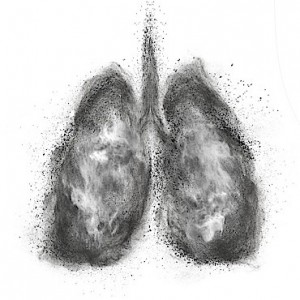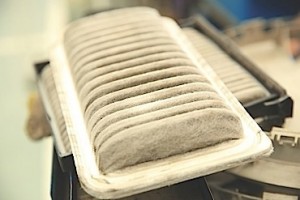
When some people think about cabin air filters, they conjure up images of summertime, air conditioning and musty smells. The reality is that cabin air filters work the majority of their magic when temperatures drop and cause winter breathing problems.
Every technician knows vehicle tailpipe emissions are higher when the engine is cold. You can smell these emissions in the air when a vehicle starts and is idling on a cold winter morning while you are scrapping the window. During these cold starts, the engine is running rich and the catalytic converter has not yet started operating. These emissions are substantial to the point that what’s coming out of the tailpipe can be damaging to the driver’s respiratory system.
According to a Kansas City Light-Duty Vehicle Emissions Study published in 2010, scientists found particulate emissions increased exponentially as the temperature decreased. They calculated that particulate emissions doubled for every 20° F temperature drop.
The most damaging component of tailpipe emissions for humans is particulates, or “soot.” Vehicle emissions particulates range in size from 2 microns to 10 microns in diameter. Smaller particulates are invisible or appear as smoke, while larger particles can be seen sticking to the end of the tailpipe. Exhaust particulates can cause serious health concerns because they can pass through the nose and throat, and then lodge deep into the tissues of the lungs. Particulates smaller than 2.5 microns in diameter can pass through lung membranes and enter the cardiovascular system.
Particulates in the exhaust can even aggravate lung diseases such as asthma and bronchitis. They can make people cough, wheeze and be short of breath. The one thing that can stop exhaust particulates from reaching vehicle occupants is a cabin air filter. Some cabin air filters can even stop particulates that are as small as 1 micron in diameter.

There are two kinds of cabin filters available for modern vehicles — particulate and activated-charcoal cabin filters. Particulate types filter out pollutants and irritants. Some filters are electrostatically charged, similar to how many household HVAC filters work, ensuring that particles stay attached to the filter. Activated-charcoal cabin filters absorb most toxic and foul-smelling gases such as nitrogen oxide, sulfur dioxide and hydrocarbons by incorporating filter media that is impregnated with charcoal.
This may seem like a scare tactic to get customers to buy more cabin air filters, so you might feel it is easier to sell a cabin air filter on the benefits of fewer smells and less pollen. But, the ability to keep particulates out of vehicle occupants’ lungs is the greatest benefit for the driver. This is the main reason why almost every new vehicle has a cabin air filter as standard equipment.
OEMs are also stepping up their game by positioning the cabin filter to filter both fresh and re-circulated air. Many automatic temperature control HVAC systems are using re-circulated air whenever possible to further reduce particulates in the cabin.
If you do not feel comfortable focusing on health benefits to sell cabin air filters during winter, there is one benefit no driver can ignore, and that’s defroster performance. If a cabin air filter is clogged, it will create a restriction that will decrease the amount of hot air the blower can deliver to the windshield. This is one benefit the driver can see with his or her own eyes.












